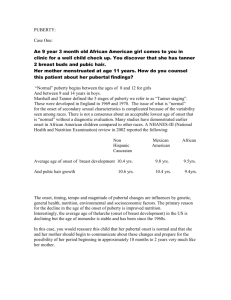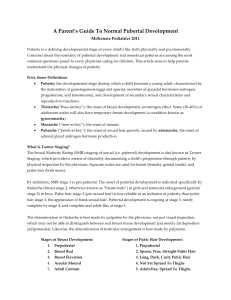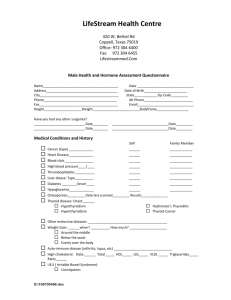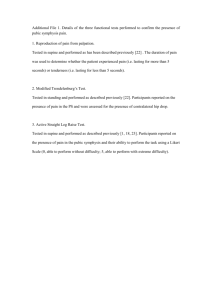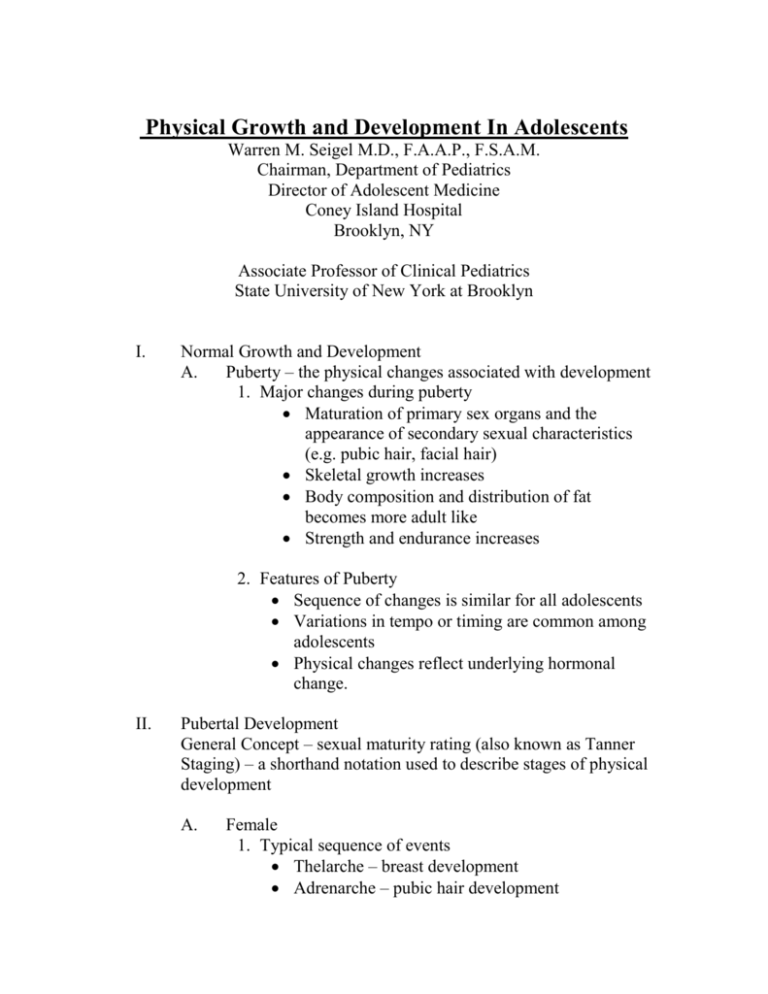
Physical Growth and Development In Adolescents
Warren M. Seigel M.D., F.A.A.P., F.S.A.M.
Chairman, Department of Pediatrics
Director of Adolescent Medicine
Coney Island Hospital
Brooklyn, NY
Associate Professor of Clinical Pediatrics
State University of New York at Brooklyn
I.
Normal Growth and Development
A.
Puberty – the physical changes associated with development
1. Major changes during puberty
Maturation of primary sex organs and the
appearance of secondary sexual characteristics
(e.g. pubic hair, facial hair)
Skeletal growth increases
Body composition and distribution of fat
becomes more adult like
Strength and endurance increases
2. Features of Puberty
Sequence of changes is similar for all adolescents
Variations in tempo or timing are common among
adolescents
Physical changes reflect underlying hormonal
change.
II.
Pubertal Development
General Concept – sexual maturity rating (also known as Tanner
Staging) – a shorthand notation used to describe stages of physical
development
A.
Female
1. Typical sequence of events
Thelarche – breast development
Adrenarche – pubic hair development
Pubarche – growth
Menarche – appearance of menses
B.
Breast Development
SMR-1:
the typical preadolescent breast.
Lacking breast tissue or significant development of
the nipple or areola
SMR-2:
the breast and papilla become
elevated and appear as a small mound. There is
increased areolar diameter as well as the
appearance of increased areolar pigmentation
SMR-3:
the breast and areola are enlarged but
are continuous in contour, with separation of the
nipple from the contour of the breast
SMR-4:
the breast and areola continue to
increase in size and mass. There is separation of
the areola and papilla of the nipple to form a
separate mound of tissue
SMR-5:
the mature female breast. The nipple
projects slightly but the areola is contiguous with
the contour of the breast
C.
Pubic Hair
SMR-1:
preadolescent
SMR-2:
sparse, downy, straight pubic hair
appears first at the medial border of the labia
majora.
SMR-3:
darker, curly pubic hair, appears at the
medical aspect of the labia majora and spreads
upward and outward in a typical triangular
distribution
SMR-4:
coarse, curly pubic hair becomes
more abundant, but less than typical adult amount
and distribution
SMR-5:
coarse, curly pubic hair, in typical
adult female distribution with pubic hair present on
the medial aspects of the thighs or coursing
upwards along linea alba up toward the umbilicus
D.
III.
Important Features of Adolescent Female Development
1. Average age of onset of puberty = 10 years (range 813).
2. Growth spurt (peak height velocity) occurs during
SMR-2.
3. Average height achieved during growth spurt = 4-6
inches.
4. Rate of growth in females decreases immediately prior
to the onset of menses.
5. Menarche (onset of menses) occurs during SMR-4 in
the majority of females (May be delayed to SMR-5
occasionally).
6. Average age at menarche = 12 years (range 10-16)
7. At menarche, the majority of females have achieved
95% of their ultimate adult height.
8. Length of puberty = 4 years
Pubertal development may be delayed by poor
health, intense exercise, low body weight, poor
nutrition, chronic illness.
9. Breast asymmetry is common in adolescent females and
does not signify pathology.
10.Acne often accompanies pubertal development and may
become severe during SMR stages 3 and 4.
PUBERTAL DEVELOPMENT IN ADOLESCENT MALES
A.
Sequence of pubertal changes in males
Enlargement of the testes
Lengthening of penis
Appearance of pubic hair
Physical growth
Sexual maturity rating (also known as Tanner
stage) are utilized in the assessment of adequacy of
males development
B.
Testicular development
SMR-1:
preadolescent testes
SMR-2:
testicles slightly enlarged, scrotal skin
darkens in pigment, texture thins
SMR-3:
testicles increase in size and volume
SMR-4:
testicles increase in size, scrotal skin
dark
SMR-5:
adult tests and scrotum
C.
Penis development
SMR-1:
preadolescent male
SMR-2:
darkening of site of circumcision (in
circumcised males), slight increase in length
SMR-3:
enlargement of the glans penis and
increase in length
SMR-4:
larger, glans and breadth increases in
size
SMR-5:
adult penis
D.
Pubic hair development
SMR-1:
preadolescent; no pubic hair
SMR-2:
sparse, downy straight pubic hair
located at the base of the pubic bone and base of
the penis
SMR-3:
coarse, darker pubic hair initially
located at the base of the penis and extending in an
upward, outward direction
SMR-4:
darker, curly pubic hair increased in
amount, in similar distribution to stage 3 but less
amount than in the adult
SMR-5:
adult masculine pubic hair
distribution to include pubic hair present at medial
aspects of the thighs. May not hair coursing
upwards alone linea alba toward the umbilicus
E.
Important features of male pubertal development
Average age of onset of puberty = 12 years (range
9-13)
Growth spurt (peak height velocity) occurs
generally between SMR-3 and SMR-4
First ejaculation occur at SMR-3
F.
Sperm production (spermarche) occurs at SMR-3
Average height gained during puberty = 5-7 inches
Strength peak occurs between SMR-4 and SMR-5
Gynecomastia (swelling of breast tissue) very
common among adolescent males; occurs in
approximately 60% of boys between SMR-2 and
SMR-4
Common concerns about puberty in adolescents
Pubertal delay – often perceived delay by the
adolescent, but within normal range
Puberty beginning early – more common in
females (may result in stress), but generally normal
variation
Partial puberty beginning early
Premature thelarche – isolated breast development
Premature adrenarche – isolated pubic hair
development
Neither premature adrenarche or thelarche indicate
significant pathology or endocrine abnormality.
Must be placed within the context of the patient
and his/her history and physical examination.
G.
Other physical or laboratory findings associated with
pubertal change in adolescents
Serum alkaline phosphatase levels rise for both
males and females during periods of rapid growth.
Elevated levels will decrease following period of
significant growth.
Hemoglobin and hematocrit will increase under
hormonal influence during period of growth.
Increase will be sustained following pubertal
change.

